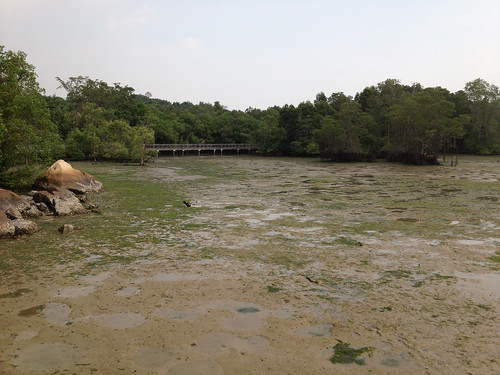
The Naked Hermit Crabs spent an enjoyable Friday morning with some special guests on the Chek Jawa Boardwalk.
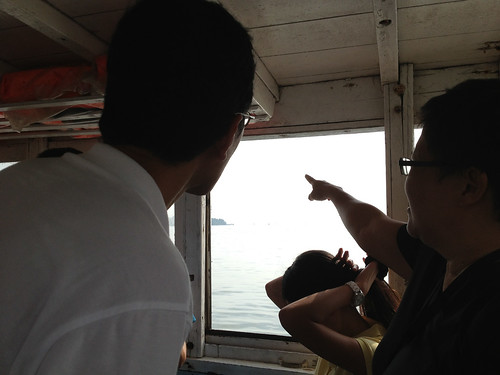
While we're on the boat en route to Pulau Ubin, Ria is already pointing out the boardwalk, which can be seen jutting out from the eastern tip of the island. And as the van brings us from Ubin town to Chek Jawa, she continues to regale us with stories about the former headman of Pulau Ubin, who passed away at the age of 101, the quarries that once supported a thriving settlement on the island, and the Thai temple that was relocated several years back.
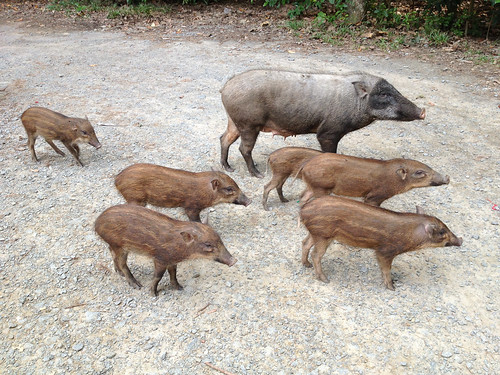
The resident wild pigs (Sus scrofa vittatus) were foraging when we arrived at Chek Jawa. The piglets are growing fast and losing their watermelon stripes. But it seems like there are only six of them, when we counted eight just two weekends ago. Grandma, the first of the wild pigs to start getting comfortable around people, made an appearance too; she's had a few daughters, some of which have since grown and bore litters of their own, like the young adult sow in this photo.

(Photo by Ley Kun)
Once the wild boar realised that we did not have any food, they wandered off. I'm glad that for now, both the human visitors and resident wild boar are still able to tolerate each other and coexist on Chek Jawa. The idea of feeding wildlife may be appealing to some, but it results in the animals learning that humans are a source of food, resulting in people being disturbed or harassed. And if people complain about animals like wild boar or monkeys turning bold and aggressive, it's the animals that ultimately bear the consequences.
With three guides, and a small audience to begin with, we decided to go as a single group. Just before we started, the wild boar made another appearance.
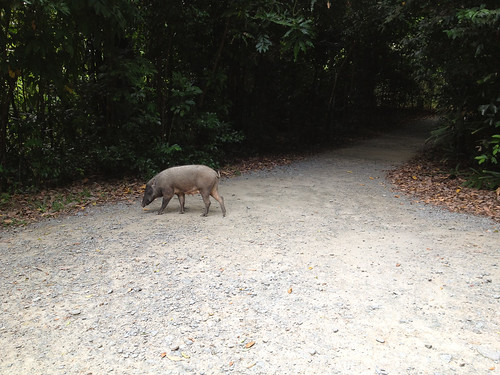
Mom crossed the path first, and we waited for the piglets to catch up and cross as well. It's never a good idea to stand between a mother and her young.
Unfortunately, it looks like for the second consecutive year, the durian (Durio zibethinus) trees at Chek Jawa won't be fruiting. I have a feeling that the weather we've been having these few years has screwed with the environmental factors that trigger flowering.
We didn't manage to spot the Oriental pied hornbills (Anthracoceros albirostris) today, but the nesting box is always a great opportunity to talk about the hornbills' return as a part of Singapore's native avifauna, and the success of the Singapore Hornbill Project.
Most conveniently, right where we stopped to look at the hornbill nest box, Ria found some fruits of the seashore nutmeg (Knema globularia). These bright red fruits are eaten by hornbills (and other frugivorous birds). Along the boardwalk, we saw that the delek air (Memecylon edule) were blooming. Both of these coastal trees are now rare, with the seashore nutmeg being Critically Endangered, and the delek air considered Endangered, as they tend to grow on coastal cliffs, a habitat that has vanished from most parts of Singapore.
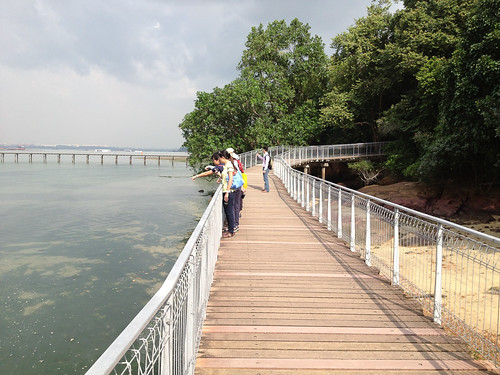
The tide was still quite low, and in the shallows beneath the boardwalk, we managed to spot some marine life, such as the huge schools of small fishes that we commonly encounter swimming alongside or beneath the boardwalk.

We also saw a couple of needlefish (Strongylura sp.);
(Photo by Ley Kun)
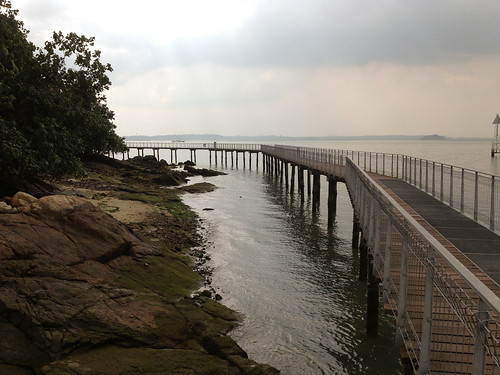
We spotted quite a few large Haddon's carpet anemones (Stichodactyla haddoni) close to the boardwalk. Despite looking like huge flowers, these animals can actually uproot themselves and move to another position, either to avoid getting buried by deposition of sediments, or to find a better feeding spot.
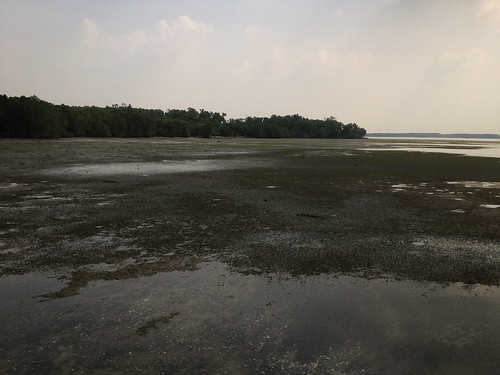
Much of the seagrass meadow was still exposed. TeamSeagrass will be having a monitoring session here on Chek Jawa tomorrow morning, which will serve as a practical and assessment for some of the volunteers. I hope they manage to meet the standards.
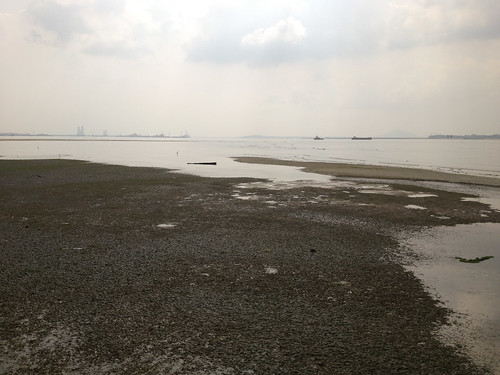
At the water's edge, we spotted several herons wading around in search of food.



(Photos by Ley Kun)
It was fascinating to see how the different heron species had partitioned the area according to size. The tallest of them all, the lone great-billed heron (Ardea sumatrana), was standing slightly further offshore compared to the smaller grey herons (Ardea cinerea). And the comparatively tiny striated herons (Butorides striatus) were staying away from the surf zone and waiting on the fringes of the seagrass meadow. Throughout this whole time, we heard the staccato chatter of the collared kingfishers (Todiramphus chloris).
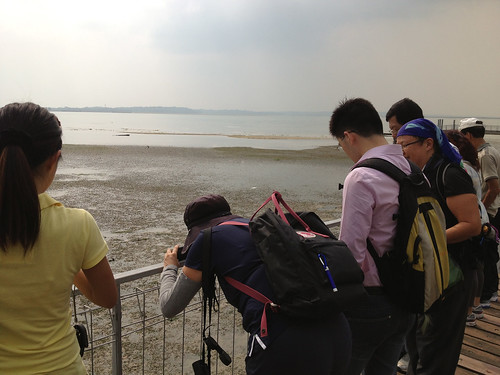
As we headed towards the mudflats and the start of the Mangrove Boardwalk, we stopped to watch the amusing antics of the fiddler crabs and mudskippers.

Some of the sea hibiscus (Talipariti tiliaceum) growing along the boardwalk were blooming;
(Photo by Ley Kun)
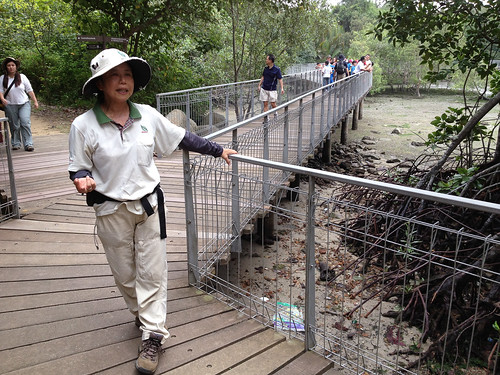
We bumped into Yook Sau and Alan from Ubin NParks, who were conducting a service learning programme for a large group of primary school students. They'd just completed a coastal cleanup session, and had also been involved in removing invasive plants from the mangroves. It's always heartening to see the younger generations being involved in outdoor activities, and playing an active role in nature conservation.

(Photo by Ley Kun)
We were distracted for a while when we noticed that an api-api ludat (Avicennia officinalis) growing next to the boardwalk had leaves encrusted with white crystals. This is actually salt that the tree had absorbed together with the water, but then managed to expel through its leaves. If you're feeling adventurous, you can always prove that it is salt by wiping a leaf with a fingertip, and then licking your finger.
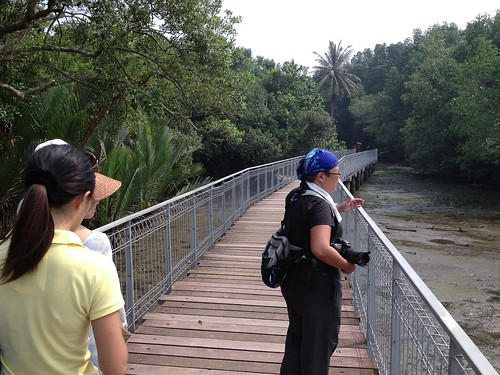
Further down, we saw the orange fiddler crabs (Uca vocans) that swarm this stretch of shore when the tide is out. With crabs frantically feeding, males waving their outsized claws at each other and at females, and occasional skirmishes in which males sized each other up, compared claw sizes, and chased intruders, it's so easy to forget all about the time while you're watching the little dramas that unfold beneath our feet.

(Photo by Ley Kun)

We saw quite a few large blue-spotted mudskippers (Boleophthalmus boddarti), which were flashing their dorsal fins at one another;
(Photo by Ley Kun)
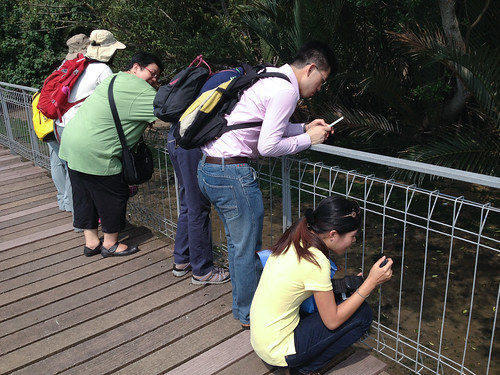


In the mangroves, we saw yet another species of fiddler crab. We haven't managed to identify this one yet;
(Photo by Ley Kun)

We also saw a number of tree-climbing crabs (Episesarma spp.) hiding amongst the mud lobster mounds. Some of our older visitors actually recalled that these crabs were traditionally harvested, preserved in black sauce and vinegar, and then eaten with Teochew porridge;
(Photo by Ley Kun)
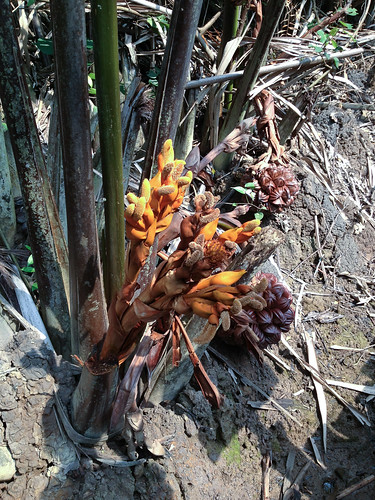
One of the nipah palms (Nipa fruticans) was flowering, and was attracting large numbers of tiny bees (too small and too quick to be photographed).
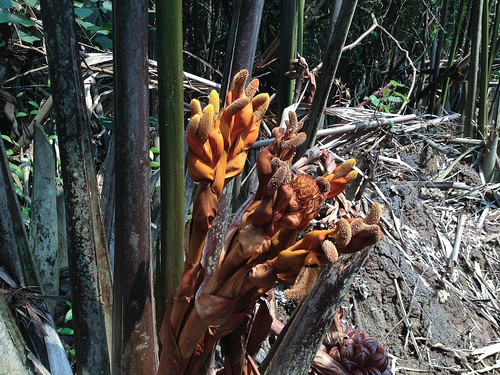
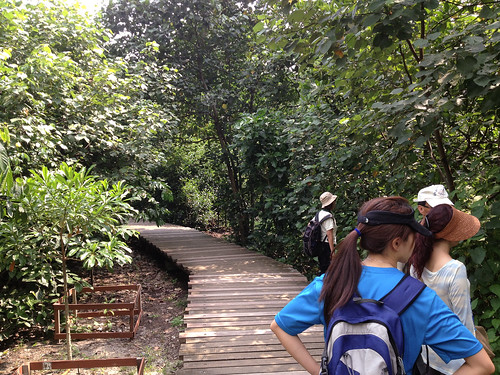

It was a little hazy when we were out on the Coastal Boardwalk, but by the time we ascended the Jejawi Tower, the situation had deteriorated considerably. Oh dear. More about this sudden return of the haze in another post.
The jejawi (Ficus microcarpa) (that gives the tower its name) and some of the surrounding trees were playing host to a small group of purple-throated sunbirds (Leptocoma sperata). Made up of both males and females, I wasn't able to count exactly how many sunbirds were there, but they were tweeting away and flitting amongst the leaves in that typical sunbird manner.
None of us managed to take a photo of the sunbirds, but here are some photos by others to illustrate just how brightly coloured and attractive the male is.
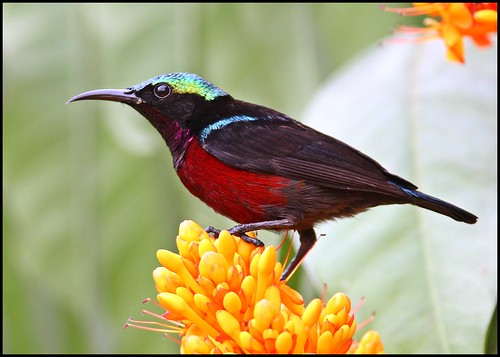
(Photo by hiker1974)
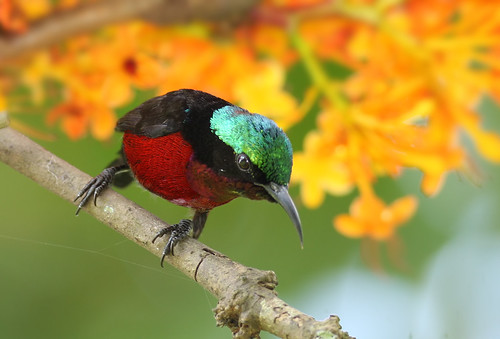
(Photo by kampang)

On the way down, Ley Kun pointed out this weaver ant (Oecophylla smaragdina) nest;
(Photo by Ley Kun)
I always like to compare weaver ant nests to bak chang or rice dumplings. Fitting for today's session, as just two days ago, many Singaporeans had commemorated the Dragon Boat Festival with the practice of consuming rice dumplings.
As we headed back towards the Information Kiosk, a male Oriental magpie-robin (Copsychus saularis) flew across the path.
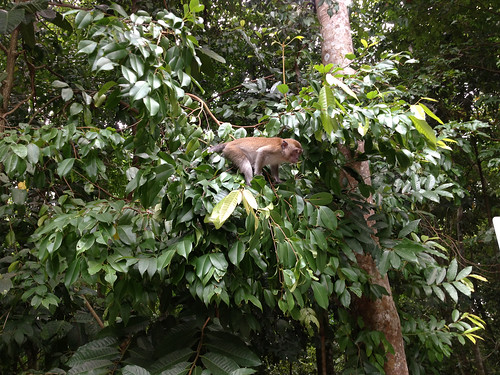
We headed back to the van and got ready to leave Chek Jawa, but not before encountering a troop of long-tailed macaques (Macaca fascicularis). Unlike elsewhere, the monkeys on Pulau Ubin are still quite wary of people, but that doesn't give us any reason to start feeding them, whether deliberately or by leaving food unattended. This juvenile was perched in some branches just above us, although most of the rest of the troop was beginning to retreat deeper into the forest.
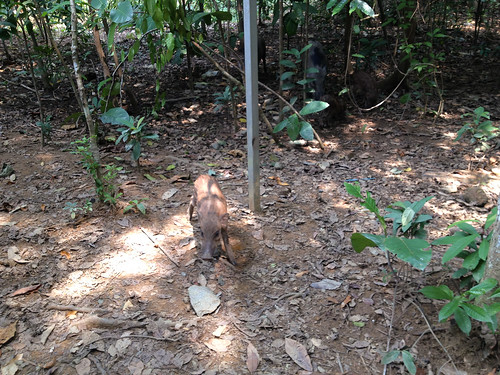
Just before we all piled into the van and departed, we saw the family of wild boar again, seeking refuge in the shade. This is a spot where I've seen the sows suckle their young, sometimes in full view of visitors.

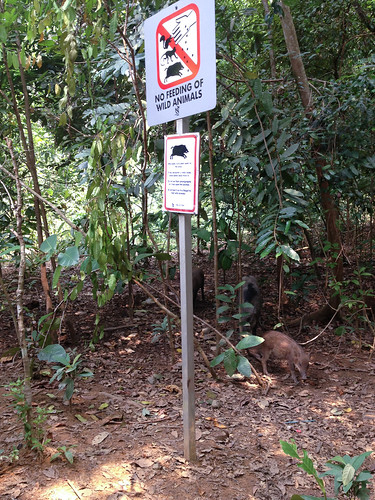
I'm amused that the wild boar conveniently chose to rest right where NParks has placed signs informing people about not feeding the wild boar, and how to behave appropriately in their presence.
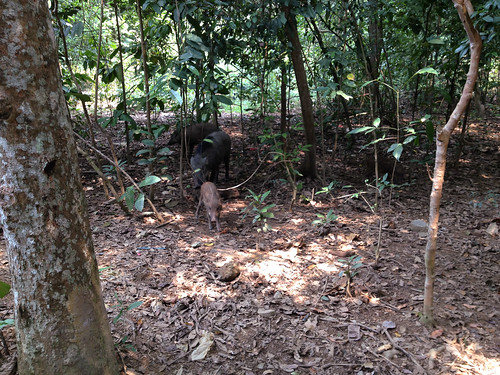
You can't really see it very clearly in this photo (thanks to that one piglet blocking the view), but one of the piglets was lying down and getting a full-body massage from Mom.
It was a fun trip, and despite the weather, we managed to encounter a lot of interesting wildlife, and shared lots of stories about Chek Jawa and its many inhabitants. I may have used these paths and boardwalks countless times over the last 5 years or so, but I'll never tire of showing people the marvels of this little gem.
Ria has written about the morning at Wild Shores of Singapore, while Ley Kun shares her experience over at Adventures with the Naked Hermit Crabs.
(Cross-posted to SBA Plus. Do support me in the Singapore Blog Awards!)